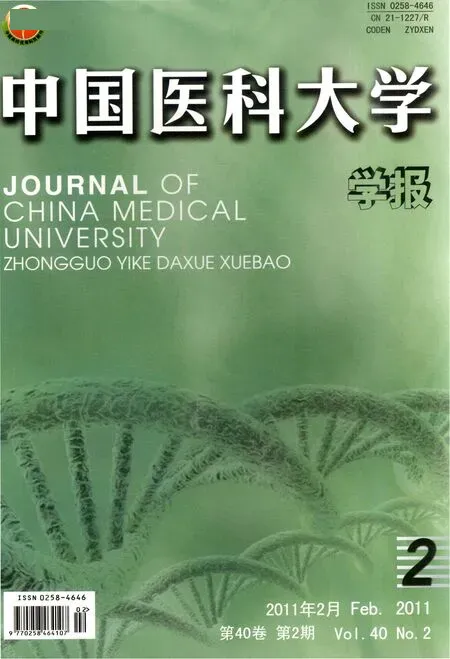先天性无虹膜患者中央角膜厚度异常分析
侯志强,许永根,王薇
(北京大学第三医院眼科,北京 100191)
先天性无虹膜患者中央角膜厚度异常分析
侯志强,许永根,王薇
(北京大学第三医院眼科,北京 100191)
目的测量先天性无虹膜患者与正常人的中央角膜厚度,分析差异存在可能的原因。方法 选取2008-2009年我院7名确诊为先天性无虹膜患者(14只眼),通过角膜内皮镜观察角膜内皮细胞的形态和密度,通过超声角膜测厚仪测量中央角膜的厚度,50只正常眼做对照。结果 患者的平均中央角膜厚度为(645±32.8)μm,正常人为(552±35.6)μm,无虹膜患者的平均中央角膜厚度明显高于正常人,差异有统计学意义(P<0.01);角膜内皮镜检查显示无虹膜患者角膜内皮细胞均正常。结论先天性无虹膜患者的中央角膜厚度明显增加,中央角膜厚度的增加与角膜内皮细胞无关;对于无虹膜患者进行眼压测量,结果会过高估计眼压。
先天性无虹膜;中央角膜厚度;青光眼
先天性无虹膜是虹膜完全或大部分缺失的先天性眼部异常,常合并有角膜混浊、白内障、眼球震颤、青光眼及黄斑发育不良等眼部异常[1]。还可有全身性异常如泌尿生殖系统疾病、智力迟钝等。先天性无虹膜多属于常染色体显性遗传。考虑到无虹膜患者发生青光眼的概率很高又较早发病,必须经常监测眼压,进行视神经的检查和房角镜检查以便给与合适的治疗。及时的房角粘连分离对一些患者可能有效[2]。由于有眼球震颤、中心视力低下,对这些患者进行常规检查存在很大困难,因此医生仍然常常依靠测量眼压来检测青光眼的发生和发展。目前许多研究表明,中央角膜厚度对于眼压测量的准确性影响很大,较厚的中央角膜将导致过高估计眼压,而较薄的中央角膜会导致低估眼压[3~6]。因此中央角膜厚度的测量对于青光眼的筛查以及检测青光眼的发展非常重要。我们对于确诊为先天性无虹膜的1个家系患者进行相关检查,希望印证无虹膜患者中央角膜厚度有无异常,并分析可能的原因。
1 材料与方法
1.1 研究对象与方法
选取2008-2009年我院确诊为先天性无虹膜患者7人(14眼,男性3人,女性4人,年龄16~46岁),通过角膜内皮镜(Noncon ROBOPACHY ICONAN)观察角膜内皮细胞的形态和密度;通过DGH-4000超声角膜测厚仪(DGH科技,Exton,宾夕法尼亚,美国)测量无虹膜患者以及50只正常眼的中央角膜厚度。患者均经详细询问病史、裂隙灯显微镜检查。检查前使用2%利多卡因注射液2ml,球后注射来减轻眼球震颤。对每只眼睛中央角膜厚度进行3次测定,以减少因眼球震颤引起的偏中心测量带来的误差。
1.2 统计学方法
2 结果
所有的无虹膜患者的角膜清亮无水肿,见图1;7人(14眼)平均中央角膜厚度为(645±32.8)μm(范围为 591~699μm);正常人为(552±35.6)μm(范围为494~585μm);无虹膜患者的平均中央角膜厚度明显高于正常人,差异有统计学意义(P<0.01)。
无虹膜患者7人(14眼)做了角膜内皮镜检查,角膜内皮细胞的六边形比例以及细胞密度均在正常范围内,检查结果见表1。


表1无虹膜患者角膜内皮镜检查结果T a b.1R e s u l t s o f s p e c u l a r mi c r o s c o p y o f p a t i e n t s w i t h a n i r i d i a No. Gender Age(year)Corneal endothelial cells CD of OD(mm2) 6A of OD(%) CD of OS(mm2) 6A of OS(%)1 male 40 2645 63 2832 512 female 46 3120 55 3205 613 male 20 2631 56 2832 544 female 44 2487 53 2583 545 female 16 3030 55 2923 616 female 35 3597 68 3039 627 male 38 3597 63 3496 67CD,density of corneal endothelial cells;6A,percentage of hexagon of endothelial cells;OD,right eye;OS,left eye.
3 讨论
先天性无虹膜是一种少见的眼部综合征,发病率为1/64000~1/96000。除了虹膜发育不良这一典型的特征外,眼部其他组织也有不同程度的受累,包括角膜、前房角、晶状体、视网膜和视神经。由于黄斑发育不良产生眼球震颤。大约有6%~75%的患者会出现青光眼,并多在青春期或成人的早期发病。先天性无虹膜患者也可出现先天性或婴幼儿青光眼[7,8]。
本研究显示无虹膜患者平均中央角膜厚度为645μm,比正常人的中央角膜厚度高出大约100μm。Aghainan等[3]报道中国人的中央角膜厚度为555.6μm,同时中央角膜厚度与年龄之间未见有明显的关系。本研究显示无虹膜患者中央角膜厚度明显增加。与 Whitson 等[9]、Brandt等[10]观察的结果一致。本研究中角膜内皮镜检查发现角膜内皮细胞形态大小及细胞密度正常,没有出现角膜内皮失代偿,因此无虹膜患者中央角膜厚度的增加并非是由角膜内皮细胞所引起。这与Whitson等[9]观察的结果一致。此外,Whitson等[9]对先天性无虹膜患者进行的共聚焦显微镜观察,显示正常的角膜上皮细胞和增厚的角膜实质层。因此可以说是由于增厚的角膜实质层导致无虹膜患者中央角膜厚度增加。目前已证实先天性无虹膜与PAX6基因突变有关,PAX6基因在眼部的发育起到非常重要的作用[11,12],为此我们考虑可能是PAX6基因的突变引起的角膜组织增厚。
有关中央角膜厚度对眼内压测量的影响目前已有很多报道。中央角膜厚度比正常值高可以导致眼压测量的误差,随着中央角膜厚度的增加,将过高估计眼压值[4]。许多患者被归类于高眼压症可能仅仅是角膜厚度比正常值高[5,6]。Damji等[13]、Liu 等[14]、Doughty等[15]在关于中央角膜厚度和眼压的关系方面进行了系统研究。Doughty等[15]的研究建议对于无青光眼的人,中央角膜厚度有10%的变化应相应调整眼压1.1mmHg,而对于有慢性眼病如原发性开角型青光眼的患者应相应调整2.5mmHg的眼压。von Eicken 等[16]认为中央角膜厚度每变化 25μm,眼压应相应调整1mmHg。
先天性无虹膜患者常常伴有黄斑发育不良、低视力以及眼球震颤,视野常常不易获得。患者可能没有注意到视力的潜在变化或者不能用语言来表达,同时传入性瞳孔障碍不能被发现。Herndon等[17]认为中央角膜厚度是决定青光眼严重性的一个强有力的临床因素,测量中央角膜厚度可以帮助医生对有高度进展危险的青光眼患者进行正确诊断。本研究提示对于无虹膜患者进行眼压测量结果会过高估计眼压。
[1]Nelson LB,Spaeth GL,Nowinski TS,et al.Aniridia.A review[J].Surv Ophthalmol,1984,28(6):621-642.
[2]Chen TC,Walton DS.Goniosurgery for prevention of aniridic glaucoma[J].Arch Ophthalmol,1999,117(9):1144-1148.
[3]Aghainan E,Choe JE,Lin S,et al.Central corneal thickness of Caucasians,Chinese,Hispanics,Filipions,AfricanAmericans,andJapanese in a glaucoma clinic [J].Ophthalmology,2004,111(12):2211-2219.
[4]Whitacre MM,Stein R.Sources of error with use of Goldmann type tonometers[J].Surv Ophthalmol,1993,38(1):1-30.
[5]Brandt JD,Beiser JA,Kass MA,et al.Central corneal thickness in the Ocular Hypertension Treatment Study(OHTS)[J].Ophthalmology,2001,108(10):1779-1788.
[6]Gordon MO,Beiser JA,Brandt JD,et al.The Ocular Hypertension Treatment Study:baseline factors that predict the onset of primary open-angle glaucoma [J].Arch Ophthalmol,2002,120(6):714-720;discussion 829-830.
[7]Ivanov I,Shuper A,Shohat M,et al.Aniridia:recent achievements in paediatric practice[J].Eur J Padiatr,1995,154(10):795-800.
[8]Eagle RC.Congenital,developmental,and degenerative disorders of the iris and ciliary body.In:Alvert DM,Jakobiec FA,eds.Principles and Practice of Ophthalmology:Clinical Practice.Vol 1.Philadelphia,Pa:WB Sauders Co,1994.364-389.
[9]Whitson JT,Liang C,Godfrey DG,et al.Central coreal thickness in patients with congenital aniridia [J].Eye Contact Lens,2005,31(5):221-224.
[10]Brandt JD,Casuso LA,Budenz DL.Markedly increased central corneal thickness:an unrecognized finding in congenital aniridia[J].Am J Ophthalmol,2004,137(2):348-350.
[11]Zumkeller W,Orth U,Gal A.Three novel PAX6mutations in patients with aniridia[J].J Clin Pathol,2003,56(3):180-183.
[12]Graw J.Genetic aspects of embryonic eye development in vertebrates[J].Dev Genet,1996,18(3):181-197.
[13]Damji KF,Muni RH,Munger RM.Influence of corneal variables on accuracy of intraocular pressure measurement [J].J Glaucoma,2003,12(1):69-80.
[14]Liu J,Roberts CJ.Influence of corneal biomechanical properties on intraocular pressure measurement [J].J Catraract Refract Surg,2005,31(1):146-155.
[15]Doughty MJ,Zaman ML.Human corneal thickness and its impact on intraocular pressure measures:a review and meta-analysis approach[J].Surv Ophthalmol,2000,44(5):367-408.
[16]vonEickenJ,KohlhassM,H觟hH.Glaucoma diagnostics and corneal thickness[J].Ophthalmologe,2005,102(9):840-848.
[17]Herndon LW,Weizer JS,Stinnett SS.Central corneal thickness as a risk factor for advanced glaucoma damage [J].Arch Ophthalmol,2004,122(1):17-21.
(编辑武玉欣,英文编辑王又冬)
Analysis of the Abnormality of Central Corneal Thickness of Patients with Congenital Aniridia
HOU Zhi-qiang,XU Yong-gen,WANG Wei
(Department of Ophthalmology,Peking University Third Hospital,Beijing 100191,China)
ObjectiveTo measure and analyze the central corneal thickness(CCT)of the patients with congenital aniridia.MethodsFourteen eyes of 7patients confirmed diagnosis of congenital anirida were examined by specular microscope to observe the modality and density of corneal endothelial cells.CCT of the patients and 50eyes of normal subjects were obtained by means of corneal pachymetry.ResultsThe average CCT of patients with aniridia and normal subjects was 645±32.8μm and 552±35.6μm respectively.Specular microscope showed normal corneal endothelial cells in patients with aniridia.ConclusionThe CCT of the patients with congenital aniridia thickens clearly.Corneal endothelial cells are not responsible for it.The measuring result of intraocular pressure of the patients with aniridia will overestimate their intraocular pressure.
congenital aniridia;central corneal thickness;glaucoma
R771
A
0258-4646(2011)02-0144-03
doiCNKI:21-1227/R.20110212.0952.011
北京市科学技术委员会资助项目(D206009000091)
侯志强(1973-),男,主治医师,博士.
王薇,E-mail:puh3_ww@bjmu.edu.cn
2010-10-21

